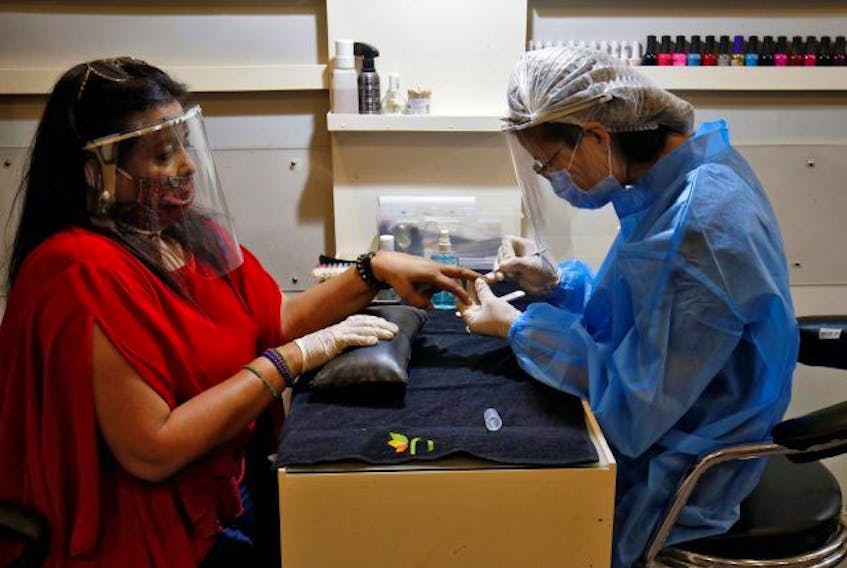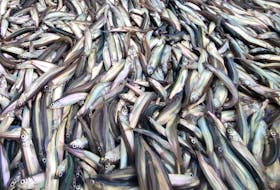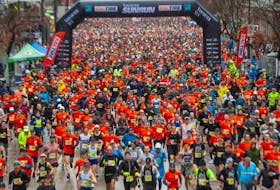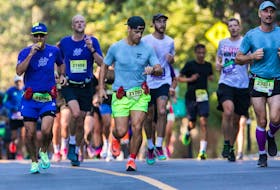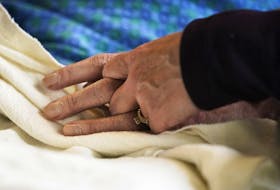It took nearly two months for Canada’s federal health leaders to come around to the case for face mask use en masse, when physical distancing is an issue, to curb COVID-19’s spread. Some experts are now suggesting we go further, with goggles or face shields, even if they make people look, as some have observed , a bit “dorky.”
World Health Organization officials said this week its infection prevention control network is discussing face shields. A University of Iowa team is already urging their adoption.
If added to the bundle of other public health measures, simple face shields cobbled together with materials found in craft and office supply stores could help drive COVID-19 infections to manageable levels, the Iowa researchers wrote in JAMA.
Layered cloth masks can filter some of the tiny, virus-sized particles that fly out when people cough, sneeze, talk or breathe. But face shields, the Iowa team said, may be a superior option. Shields can be easily cleaned with soap and water, or household disinfectants, and “reused indefinitely.” They’re comfortable to wear, block the virus from entering “portals,” (mouths, noses and eyes) and “reduce the potential for autoinoculation,” meaning implanting the virus into our own bodies after touching a contaminated surface, by preventing the wearer from touching his or her face.
We can also see each other through them.
Another review published in The Lancet suggested face shields, visors or goggles might significantly reduce the chance of viral infection or transmission, from 16 per cent with no eye covering, to six per cent. The World Health Organization commissioned the review, which synthesized all available evidence on physical distancing, mask wearing and eye protection. The studies weren’t randomized, most reported on SARS or MERS, not Sars-Cov-2, they involved mostly health-care settings, and the authors said they can’t be “overly certain in the precise quantitative estimates of effects.” Still, they concluded that, for the general public, physical distancing of more than one metre is “highly effective” (distances of two metres, even better), face masks protect people against infection and that eye protection, while “typically under-considered” can confer added benefit. None of them, they stressed, give complete protection.
“We label the evidence about eye protection as low certainty, meaning any effects are suggestions,” scientific lead Derek Chu, a clinician scientist at McMaster University, said in an email. The exact risk of transmission varies between studies, he said, and it’s “not yet clear the relative contribution of eyes, versus nose vs. mouth.” It’s impossible to say how large the effect might be, he said.
While SARS-CoV-2 is spread by breathing in tiny liquid virus-containing droplets, there is evidence it can enter the body through mucus membranes, including the mucus membranes on the surface of the eye and inner eye lids.
Pink eye, or conjunctivitis, has been reported as a possible sign of COVID-19. A brief report involving 38 people with COVID-19 in Hubei Province, China, found “ocular abnormalities” consistent with conjunctivitis in one-third of them. “Although there is a low prevalence of SARS-CoV-2 in tears,” the authors wrote in JAMA Ophthalmology , “it is possible to transmit the virus via the eyes.”
There’s been no randomized trial of face shields versus cloth masks. However, one 2014 study suggested face shields can keep people from inhaling 96 per cent of flu-laden droplets immediately after a cough, when standing within 18 inches of someone coughing.
When the study was repeated at today’s recommended six-feet of physical distancing separation, the shields blocked inhaled virus by 92 per cent, which, according to the Iowa team, is “similar to distancing alone and reinforces the importance of physical distancing in preventing viral respiratory infections.”
Goggles have been shown to reduce transmission of infectious diseases, including SARS.
Speaking at a media briefing this week in Geneva, Dr. Maria Van Kerkhove, head of WHO’s emerging diseases and zoonosis unit, who later had to walk back from a comment that asymptomatic silent spreaders are “very rare,” said there’s a role for face shields if masks aren’t available. “But that’s something that needs to be discussed on where and when (shields) can be best used.” Among the concerns is that face shields lack a good seal, and it’s not clear how effective they are at “source control” — how good they are at stopping viral droplets from being coughed or sneezed out by someone who is infected but has no symptoms.
“I should remind you that masks alone will not protect you. Face shields alone will not protect you from infection,” Van Kerkhove said. All measures, including physical distancing, remain “really paramount,” she said.
Dr. Isaac Bogoch is a big fan of face shields. “They’re far more comfortable to wear, there’s no breathing issues with them, they’re not uncomfortable on hot summer days,” said Bogoch, an infectious diseases specialist with Toronto’s University Health Network, who is seeing more people on the streets wearing face shields. “They definitely cover the eyes, the nose and the mouth. You’re less likely to touch your face, because you’ve got a shield on,” Bogoch said.
“The other beautiful aspect of them is that there are no issues with verbal and non-verbal communication. You can see people’s faces right through them. The psychological and social benefits are significant.”
We don’t yet know if face shields are better, worse or equivalent to face masks. That’s being studied, Bogoch said. “I’m not here to tell people what to do. I’m here to help people make informed decisions for themselves. But I think we should at least be open-minded to it.”
Copyright Postmedia Network Inc., 2020

